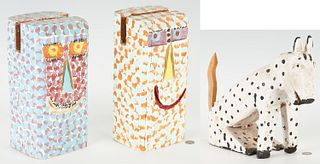Neolithic Marble Steatopygous Idol (Voluptuous Female)
About Seller
686 S Taylor Ave, Ste 106
Louisville, CO 80027
United States
Selling antiquities, ancient and ethnographic art online since 1993, Artemis Gallery specializes in Classical Antiquities (Egyptian, Greek, Roman, Near Eastern), Asian, Pre-Columbian, African / Tribal / Oceanographic art. Our extensive inventory includes pottery, stone, metal, wood, glass and textil...Read more
Two ways to bid:
- Leave a max absentee bid and the platform will bid on your behalf up to your maximum bid during the live auction.
- Bid live during the auction and your bids will be submitted real-time to the auctioneer.
Bid Increments
| Price | Bid Increment |
|---|---|
| $0 | $25 |
| $300 | $50 |
| $1,000 | $100 |
| $2,000 | $250 |
| $5,000 | $500 |
| $10,000 | $1,000 |
| $20,000 | $2,500 |
| $50,000 | $5,000 |
| $100,000 | $10,000 |
| $200,000 | $20,000 |
About Auction
Jun 27, 2024
Classical antiquities, ancient and ethnographic art from cultures encompassing the globe. Artemis Gallery info@artemisgallery.com
- Lot Description
Southeastern Europe, Balkans / Mediterranean Region, late Neolithic / Early Bronze Age, ca. 5000 to 3000 BCE. An important Neolithic marble voluptuous female figure known as a "steatopygous" idol, due to the "tissue" on the thighs and buttocks. The oversized head, full breasts, rounded stomach, thick thighs, and buttocks - are undoubtedly indicative of fertility. This statuette is exceptional for its relatively large head, skillfully designed composition, symmetry, harmonious proportions, and the beauty of the highly polished stone. The represented figure's pose and folded arms suggests lying on the back or ground in burial context, although the figure can stand alone without support - the buttocks and thighs establish the base for the torso, with the surmounting head which follows the median axis almost exactly. This idol has considerable tactile appeal and was most likely designed to be handled. Size: 4.5" H (11.4 cm)
Statuettes of sitting, standing or reclining figures with overexaggerated, voluminous shapes (especially of buttocks, breasts, and mid-sections) are characteristic for the Neolithic culture and found in many areas of the Near East, the greater Mediterranean area, and also in Eastern, Central and Western Europe. It is generally assumed that this female form relates such figures to the fertility goddess, the Great Mother, whose cult was primary in the religion of early human civilization. During the Neolithic period, the various agricultural societies compared female fertility to rich land for crops. Steatopygous bodies symbolized sustenance, motherhood, and breastfeeding. This present statuette slightly differs from other known types, because instead of the ample mid-section that shows the sign of pregnancy, the waist is thin and the breasts are small, which may suggest that the person is young, healthy, and the idealized body type. This brings the idea that the concept of this image also included the implications of the goddess of beauty.
Please note that this piece is a dropship item, meaning that it will be shipping from the consignor's location. All information regarding condition, size, stone identification, and metal content have been provided by the consignor.
Provenance: East Coast collection, New York Gallery, New York City, New York, USA, acquired in April 2024 via Plakas Auctions, London, United Kingdom; ex-private Dutch collection, acquired October 18, 2015; ex-important Poland collection, acquired by descent by the previous family collection, Poland-Greece; ex-Important Greek collection of R.W.B. Pardiak, 1960s to 2000, acquired by descent; ex-private Greek collection, by descent from the owner's grandfather, 1930s to 1960s; excavated and acquired prior to 1920s to 1930s
All items legal to buy/sell under U.S. Statute covering cultural patrimony Code 2600, CHAPTER 14, and are guaranteed to be as described or your money back.
A Certificate of Authenticity will accompany all winning bids.
We ship worldwide and handle all shipping in-house for your convenience.
#187330Condition
Completely intact and in excellent state of preservation. The surface is soft, with pitting in stone surface and traces of original polishing and tooling. The stone structure and stone surface has small ancient cracks and pitting as expected with age, with deep hard sediment deposits. Entirely preserved, no restorations or repairs. The surface slightly cleaned with some weathering.
- Shipping Info
-
All shipping is handled in-house for your convenience. Your invoice from Artemis Gallery will include shipping calculation instructions. If in doubt, please inquire BEFORE bidding for estimated shipping costs for individual items.
-
- Buyer's Premium



 EUR
EUR CAD
CAD AUD
AUD GBP
GBP MXN
MXN HKD
HKD CNY
CNY MYR
MYR SEK
SEK SGD
SGD CHF
CHF THB
THB












